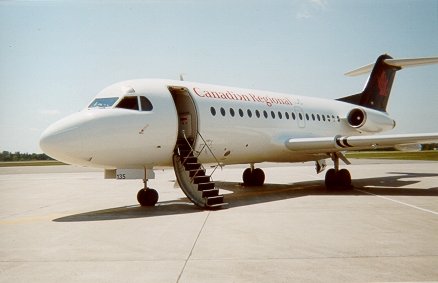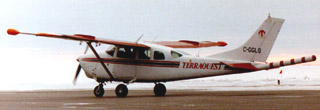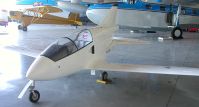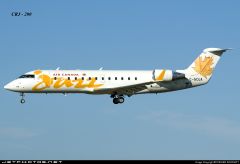 This aircraft had only been out of the
paint shop three days and gleamed in the morning sun. I went back into the
terminal building, purchased one of those disposable cameras and snapped a few
shots.
This aircraft had only been out of the
paint shop three days and gleamed in the morning sun. I went back into the
terminal building, purchased one of those disposable cameras and snapped a few
shots.
The Jurassic Jet
The Fokker F28
Here she is on the ramp in Fredericton. We were scheduled
to fly to St. John but the fog prevented a landing. Fredericton offered
clear sky's and warm temperatures. I turned that airplane around and
headed straight for the sunshine.  This aircraft had only been out of the
paint shop three days and gleamed in the morning sun. I went back into the
terminal building, purchased one of those disposable cameras and snapped a few
shots.
This aircraft had only been out of the
paint shop three days and gleamed in the morning sun. I went back into the
terminal building, purchased one of those disposable cameras and snapped a few
shots.
People often ask me what airline I fly for and which aircraft. Well, this was it (up until I broke my back - not an aviation accident). Unfortunately, this type of aircraft has been retired from the Air Canada fleet, and when I return to work, I will be retraining on the CRJ 200. Newer but less cool, like an old Vette to a new Saturn.
A few of the points that make this aircraft special are for one... the big wheels. Yes. The big wheels for an aircraft this size. It may look like a Tonka toy but how many jets can you stuff down on a gravel runway? - Two, the fat wings. It takes a lot to stop this aircraft, not like that pussy CRJ. OK... it's a bit slower. - The speed brakes (big barn doors that get stuck out into the wind by 3000 psi hydraulic pressure from the side of the tail), the trick that few jets can do is "slow down & go down". Most jets do one or the other, one at a time. We could slam-dunk this old Jurassic Jet almost anywhere. Air traffic controllers love us for it. - The big, roomy and bright cockpit. Well how would you like to be crammed up all day? Like in some of those less well thought out designs.
65 Passengers 4 Crew 65,000 lb gross weight
Update - July 2006
Although my back is not completely healed, I've got my aviation medical back,
done the training on the CRJ 200 and CRJ 705 (see below), and am flying on a reduced flight schedule.
I'm actually back in the saddle! :)
Terraquest's old Cessna 206. C-GGLS
This ugly bird is aviations version of that reliable old beat'er pickup truck you'd ever want to trust you're life in, and never ever let be sold to anyone.
 I've
got a thousand or so hours in this plane. We'd load her down with eight
hours of fuel (three barrels of avgas; that's a lot when you've got to hand pump
it into the wings) and go bounce around over the Black Spruce and the
Tundra. I've seen Wolves and Caribou while sitting at her
controls. I've operated her in -45 degree C weather, actually left a
con-trail (from a piston engine???) with this bird. She'd keep us warm and
toasty.
I've
got a thousand or so hours in this plane. We'd load her down with eight
hours of fuel (three barrels of avgas; that's a lot when you've got to hand pump
it into the wings) and go bounce around over the Black Spruce and the
Tundra. I've seen Wolves and Caribou while sitting at her
controls. I've operated her in -45 degree C weather, actually left a
con-trail (from a piston engine???) with this bird. She'd keep us warm and
toasty.
As you can see from the photo, she was loaded down with a lot of scientific equipment. "We'd be lookin' for gold in them there hills". And hills are exactly what we flew this bird at. Flying survey lines at one hundred feet off the ground (and they tell students to never - never fly low), we'd point her right at the hills, pull her over the top, push her back down the other side, and dunk her down into the river valleys. While "on-line" we'd have to keep the wings level so we were slipping and skidding like that average flight instructor would take away your pilot's license. We'd bank her over to 60 degrees in the end-turns so the mag-boom would skim twenty feet form the tips of the trees. On ferry flights or going out to the survey site - anything above a thousand feet we'd get nosebleeds. And talk about slow! With all that drag, we'd only get a hundred and fifteen knots. Returning to the landing strip, we'd have to bed her down with wing covers and equipment heater for the night.
That mag' survey stuff was a lot of work, but this was one of the best aircraft I've had the pleasure of flying. Adding an element of "Very Cool", she's still breaking in young pilots after all these years.
Big toys for a big boys??? The BD-5 J
Actually this aircraft is about a small as you could get. This was the aircraft everyone wanted back in the late 70's when I was learning to fly. If I had too much mad money, I would get one yesterday. I've never had the opportunity to fly one, but I can dream.
 It was designed by aircraft design guru Jim Beedee. The original design
used a fifty horse engine and flew over 225 mph. This was followed by a
jet version that used a small engine from a drone target aircraft. The jet
did another hundred mph faster. The BD-5 J was use in the James Bond movie
Octapussy. The Coors brewing company flew them with their Silver Bullets
aerobatics team.
It was designed by aircraft design guru Jim Beedee. The original design
used a fifty horse engine and flew over 225 mph. This was followed by a
jet version that used a small engine from a drone target aircraft. The jet
did another hundred mph faster. The BD-5 J was use in the James Bond movie
Octapussy. The Coors brewing company flew them with their Silver Bullets
aerobatics team.
There are still plenty of kits available and there has been nothing like it to this day.
My Current Gig. The RJ
 The
CRJ - 200: This is the Bombardier Regional Jet. This design started
life as a wide body business jet back in the 80's, built in Montreal
Canada. Fast forward a few years and Bombardier stretched it into a
regional airliner. It has a super critical wing, meaning - "it goes
like stink" but climb performance sucks. This thing has all the
bells and whistles but it's designed to let the computer fly it. As a
pilot of this thing, one feels like they are operating a video game. It's
easier to operate and presents a ton more information to the pilots, just that -
like any computer - learning the software is a challenge.
The
CRJ - 200: This is the Bombardier Regional Jet. This design started
life as a wide body business jet back in the 80's, built in Montreal
Canada. Fast forward a few years and Bombardier stretched it into a
regional airliner. It has a super critical wing, meaning - "it goes
like stink" but climb performance sucks. This thing has all the
bells and whistles but it's designed to let the computer fly it. As a
pilot of this thing, one feels like they are operating a video game. It's
easier to operate and presents a ton more information to the pilots, just that -
like any computer - learning the software is a challenge.
 The
CRJ - 705: As I said, the 200's climb performance sucks. Bombardiers
answer is the newer airframe in 70 and 95 seat versions. Just that - the
Air Canada Union "runs the airline", and us Jazz guys (who get jerked
around by mainline at every turn) are limited to 75 seat jets. Jazz
Airline needed to get some larger aircraft but Bombardier was sold out of the 70 seat
ones, so they ripped 20 seats out of the 95 seat version, re-certified it to
75, and now we get to fly around "light". Flying around light
translates to "goes like stink" and "climbs like a home sick
angle". Ok - it's not the F-28 but the 705 is a lot of fun!
The
CRJ - 705: As I said, the 200's climb performance sucks. Bombardiers
answer is the newer airframe in 70 and 95 seat versions. Just that - the
Air Canada Union "runs the airline", and us Jazz guys (who get jerked
around by mainline at every turn) are limited to 75 seat jets. Jazz
Airline needed to get some larger aircraft but Bombardier was sold out of the 70 seat
ones, so they ripped 20 seats out of the 95 seat version, re-certified it to
75, and now we get to fly around "light". Flying around light
translates to "goes like stink" and "climbs like a home sick
angle". Ok - it's not the F-28 but the 705 is a lot of fun!
Both aircraft have virtually the same cockpit and operations procedures, so all of us jet jockeys operate either aircraft on any flight.